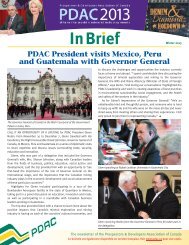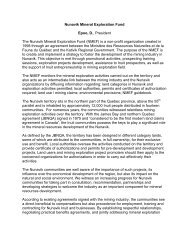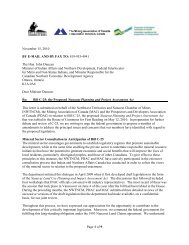The geology of the Relincho porphyry Cu-Mo deposit ... - PDAC
The geology of the Relincho porphyry Cu-Mo deposit ... - PDAC
The geology of the Relincho porphyry Cu-Mo deposit ... - PDAC
Create successful ePaper yourself
Turn your PDF publications into a flip-book with our unique Google optimized e-Paper software.
<strong>The</strong> current erosion level exposes predominantly potassic alteration, which is<br />
distinguished by hydro<strong>the</strong>rmal biotite replacement <strong>of</strong> hornblende and primary biotite and<br />
primary feldspar replaced by hydro<strong>the</strong>rmal potassium feldspar. Hydro<strong>the</strong>rmal<br />
potassium feldspar also forms narrow halos to some early quartz veinlets. Potassic<br />
alteration is locally overprinted by weak phyllic alteration recognized by incipient sericite<br />
replacement <strong>of</strong> primary feldspars in granodiorite and <strong>porphyry</strong> phases, along with<br />
sparse sulphide veinlets dominated by pyrite with sericite halos. <strong>The</strong> phyllic event may<br />
also be responsible for partial conversion <strong>of</strong> primary and hydro<strong>the</strong>rmal biotite to chlorite.<br />
Chlorite and epidote characteristic <strong>of</strong> propylitic alteration are ubiquitous throughout <strong>the</strong><br />
<strong>deposit</strong> as replacements <strong>of</strong> primary minerals and in veinlets cutting all inter-mineral<br />
intrusions, indicating a late timing.<br />
Cross- cutting relations show evolution <strong>of</strong> veining over time beginning with early dark<br />
micaceous (EDM) bands composed <strong>of</strong> phlogopite, muscovite and quartz accompanied<br />
by abundant bornite and chalcopyrite. <strong>The</strong>se are cut by aplitic dikes (vein-dikes),<br />
followed by biotite-sulphide veinlets, sulphide-bearing quartz veinlets and finally pyritedominant<br />
sulphide veins with sericitic haloes (D-type veins). Magnetite is present in<br />
some <strong>of</strong> <strong>the</strong> EDM bands and early quartz veinlets. EDM bands are distributed in<br />
equigranular granodiorite around <strong>the</strong> early <strong>porphyry</strong> stocks but are not found within<br />
<strong>the</strong>m. <strong>The</strong> highest quartz vein densities are located in granodiorite immediately adjacent<br />
to <strong>the</strong> early <strong>porphyry</strong> stocks and decline outward. Termination <strong>of</strong> some quartz veinlets<br />
against early <strong>porphyry</strong> contacts suggests some veining and mineralization preceded<br />
intrusion <strong>of</strong> <strong>the</strong> early <strong>porphyry</strong> phases.<br />
<strong>Relincho</strong> displays a typical sulphide mineral zonation from a bornite-chalcopyrite<br />
assemblage in and around <strong>the</strong> early <strong>porphyry</strong> stocks outward and possibly upward to<br />
zones <strong>of</strong> chalcopyrite and chalcopyrite-pyrite. Late <strong>porphyry</strong> phases invariably contain<br />
high pyrite to chalcopyrite ratios. Sulphide zonation is not evident in hydro<strong>the</strong>rmal<br />
breccias, ra<strong>the</strong>r bornite-dominant and chalcopyrite-dominant assemblages that form<br />
cement appear to be associated with discrete hydro<strong>the</strong>rmal breccia-forming events.<br />
References<br />
Abad, E., 1980. <strong>Cu</strong>adrángulos Estación Algarrobal, Yerbas Buenas, Cerro Blanco,<br />
Merceditas y Tres <strong>Mo</strong>rros, Región de Atacama: Instituto de Investigaciones Geológicas,<br />
Carta Geológica de Chile, 1980.<br />
Teck Resources Limited, 2012. 2011 Annual Information Form, Vancouver, Canada,<br />
March 5, 2012, 105p.





![Fredy Marino.ppt [Read-Only]](https://img.yumpu.com/46988510/1/190x146/fredy-marinoppt-read-only.jpg?quality=85)







